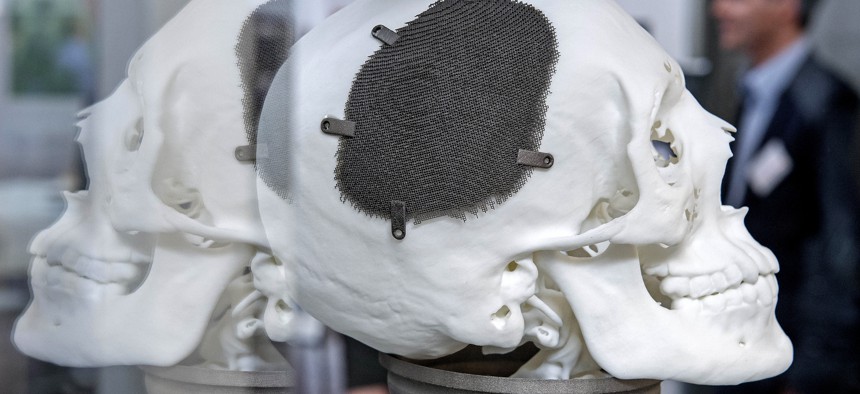How 3-D Printing Could Make Criminals Harder to Catch

A man stands behind a 3D print of a fully porous titanium grade five cranial implant for a patient. Jens Meyer/AP
Advanced technology could encourage criminals to be better educated, a new report claims.
Not too far in the future, criminals could use 3-D printers to manufacture and sell their own drugs. They might even print their own human organs and use online messaging services to coordinate distribution to traffickers, or directly to customers. Instead of relying on international crime organizations, large-scale illegal activity could dissipate, favoring instead the criminals who can use technology to create, sell and evade law enforcement at the local level.
At least, that’s what a group of 55 experts predicts for the evolution of crime over the next 15 years. In a new report, WikiStrat – a consulting firm that polls large groups of experts called – warns law enforcement agencies they are “about to find themselves on the losing side of technological improvements,” and they should consider hiring more tech experts. They should also consider monitoring emerging technology such as 3-D printing.
WikiStrat asked its “crowd” -- including academics, private sector representatives, former law enforcement agents, and experts studying money laundering schemes and the Russian mafia -- to discuss crime scenarios of the future, and then vote on their likelihood. Cases they dreamed up included sending unmanned drones to smuggle drugs across borders, using 3-D printers to produce illegal goods instead of procuring them, and messaging other criminals online to coordinate the delivery and trafficking of these goods.
Generally, WikiStrat project management group leader Oren Kesler told Nextgov, advanced technology could usher in the “return of the do-it-yourself” crime. Decentralizing the production of illegal goods could mean “[c]riminal organizations will no longer have to hold distinct territories, and crime will spread” to regions where it didn’t exist before, and where activity is less regulated, the report said.
As a result, traditional trafficking routes could be disrupted and “will no longer be an opportunity for law enforcement to discover and interdict crime,” the WikiStrat group predicted.
As 3-D printers could soon become common consumer products, “it’s going to be even harder to follow the supply chain,” Kesler said.
And the advantage technology could give criminals could “further professionalize crime, increasing incentives for criminals to be well-educated (or for well-educated individuals to become criminals) and consequently increasing the difficulties of capturing them,” the report stated.
Experts concluded law enforcement should focus on its “white-collar capabilities,” and consider tracking the use of advanced technology such as 3-D printers. However, Kesler noted such measures might require lower privacy standards for consumers.


